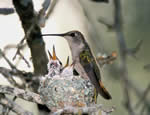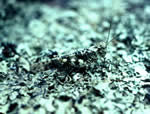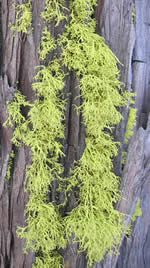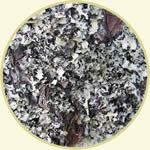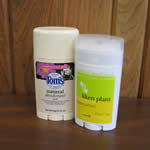USDA Forest Service Celebrating Wildflowers
|
|
|
 |
|
Lichens - Did You Know?
Lichens have been used for many things by both animals and humans. They provide forage, shelter, and building materials for elk, deer, birds, and insects. In fact, some insects have adapted their appearance to look like lichens, which are a large part of their habitat. Some insects change their appearance through evolution while others simply use lichens as a disguise. Humans use lichens for dyes, clothing, and decoration, but did you know that people also eat lichens? Bryoria is a common genus of lichen across the United States. In times of hardship, some Native American tribes would eat this lichen while other tribes sought it out. Some lichens were fed to pets during hard times as well.
Be careful though, not all lichens are edible, and in fact, some can be poisonous. For example, the wolf lichen got its name because it was used in Europe to poison wolves. Of course, the broken glass mixed with the lichens might have had something to do with it. Some Native American tribes used wolf lichen for poisoned arrowheads, yet other tribes made tea out of it. Another poisonous lichen, Parmelia molliuscula (also known as "ground lichen"), was determined to be the cause of death for 300 elk in Wyoming in 2004. Visiting elk from Colorado ate this lichen, which caused tissue decay and eventual death. The native elk were not affected, simply because their immune systems were already equipped to deal with this toxic lichen. This is another example of wildlife and plant life evolving with each other. This lichen has also been known to poison sheep and cattle. "Ground lichen" can also be used as a dye for clothing. Many lichens have been used for dyes. When mixed with another substance, such as pine sap or water, or burnt to ash first and used, lichens provide a variety of colors such as yellow, brown, green, orange, purple, and red. These dyes can be used for clothing or baskets. Examples include Lobaria pulmonaria, Parmelia saxatilis, Parmotrema, and Umbilicaria.
Other lichens, like Usnea, are researched for their antibiotic properties for use in the development of drugs, and a variety of other products use lichen in their ingredient lists today. For example, lichens are used in deodorant, toothpaste, salves, extracts, and perfumes. In Japan, they use lichens in paint for its anti-mildew properties. Be careful, though, in what you use; a few people have been known to have allergic reactions to lichens, resulting in skin disorders. Visit Lichens of North America for more information about the uses of lichens, as well as other lichen information. |
|
| NOTE: PDF format links require the Adobe Acrobat Reader to view. | |
| top | Disclaimers | FOIA | Privacy Policy | Quality of Information | Photo Credits & Use |
Location: http://www.fs.fed.us/wildflowers/interesting/lichens/didyouknow.shtml
Last modified: Tuesday, 24-Jun-2008 21:54:34 EDT
